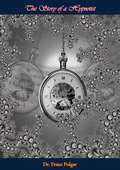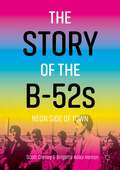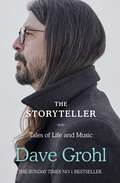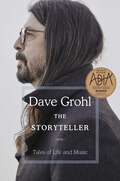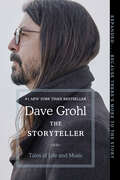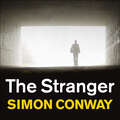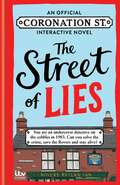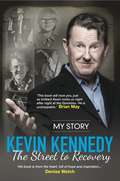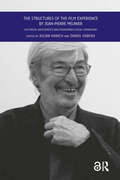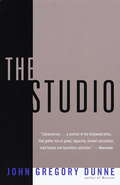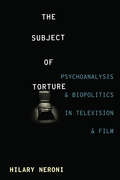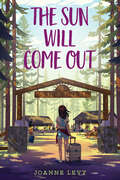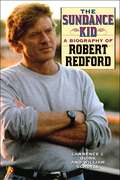- Table View
- List View
The Story of a Hypnotist
by Kurt Singer Dr Franz Polgar"Dr. Franz Polgar (April 18, 1900 - June 1979) was a renowned psychologist, hypnotist, lecturer and entertainer. Born in city of Enying, Hungary, he earned a PhD in Psychology from the University of Budapest. In his 1951 autobiography Polgar claimed that he had served as Sigmund Freud's "medical hypnotist" (Polgar's term) in 1924 and had worked in close association with Freud for six months and had assisted in the treatment of Freud's patients. He immigrated to the United States in 1935 and honed his hypnotism skills by working in speakeasy bars in New York City. He married his wife, Lillian, in 1938 and she became his booking and publications manager. They had two children, Julian and Risa."
The Story of the B-52s: Neon Side of Town
by Scott Creney Brigette Adair HerronThe Story of the B-52s: Neon Side of Town is the first critical history of one of the most legendary and influential bands in American popular music. Locating The B-52s in the intellectual climate of their hometown of Athens, GA and following the band from New York’s downtown scene in the early 1980s to their upcoming farewell tour, the book argues that The B-52s are much more significant political and musical influences on American society than their reputation as a silly party band suggests, and that their ongoing commitment to values including cooperation, mutual support, and using disruptive fun as a form of social change are an antidote to the neoliberalization sweeping both Athens and the rest of the Western world. For example, the book shows how the band synthesized influences from the modern artists displayed at the University of Georgia art museum, early queer activism on campus in the 1970s, and their experiences as queer people living through the AIDS crisis to create music that continues to be artistically and politically influential today. The authors are active members of the Athens, GA music scene, and the book includes original interviews with a range of number close to the band.
The Story of the Trapp Family Singers
by Maria Augusta TrappWith nearly 1,500 Broadway performances, six Tony Awards, more than three million albums sold, and five Academy Awards, The Sound of Music, based on the lives of Maria, the baron, and their singing children, is as familiar to most of us as our own family history. But much about the real-life woman and her family was left untold.Here, Baroness Maria Augusta Trapp tells in her own beautiful, simple words the extraordinary story of her romance with the baron, their escape from Nazi-occupied Austria, and their life in America.Now with photographs from the original edition.
The Storyteller: Tales of Life and Music
by Dave GrohlSo, I’ve written a book. Having entertained the idea for years, and even offered a few questionable opportunities (‘It’s a piece of cake! Just do four hours of interviews, find someone else to write it, put your face on the cover, and voila!’), I have decided to write these stories just as I have always done, in my own hand. The joy that I have felt from chronicling these tales is not unlike listening back to a song that I’ve recorded and can’t wait to share with the world, or reading a primitive journal entry from a stained notebook, or even hearing my voice bounce between the Kiss posters on my wall as a child. <p><p> This certainly doesn’t mean that I’m quitting my day job, but it does give me a place to shed a little light on what it’s like to be a kid from Springfield, Virginia, walking through life while living out the crazy dreams I had as young musician. From hitting the road with Scream at 18 years old, to my time in Nirvana and the Foo Fighters, jamming with Iggy Pop or playing at the Academy Awards or dancing with AC/DC and the Preservation Hall Jazz Band, drumming for Tom Petty or meeting Sir Paul McCartney at Royal Albert Hall, bedtime stories with Joan Jett or a chance meeting with Little Richard, to flying halfway around the world for one epic night with my daughters…the list goes on. I look forward to focusing the lens through which I see these memories a little sharper for you with much excitement.
The Storyteller: Tales of Life and Music
by Dave GrohlSo, I&’ve written a book. Having entertained the idea for years, and even offered a few questionable opportunities (&‘It&’s a piece of cake! Just do four hours of interviews, find someone else to write it, put your face on the cover, and voila!&’), I have decided to write these stories just as I have always done, in my own hand. The joy that I have felt from chronicling these tales is not unlike listening back to a song that I&’ve recorded and can&’t wait to share with the world, or reading a primitive journal entry from a stained notebook, or even hearing my voice bounce between the Kiss posters on my wall as a child. This certainly doesn&’t mean that I&’m quitting my day job, but it does give me a place to shed a little light on what it&’s like to be a kid from Springfield, Virginia, walking through life while living out the crazy dreams I had as young musician. From hitting the road with Scream at 18 years old, to my time in Nirvana and the Foo Fighters, jamming with Iggy Pop or playing at the Academy Awards or dancing with AC/DC and the Preservation Hall Jazz Band, drumming for Tom Petty or meeting Sir Paul McCartney at Royal Albert Hall, bedtime stories with Joan Jett or a chance meeting with Little Richard, to flying halfway around the world for one epic night with my daughters…the list goes on. I look forward to focusing the lens through which I see these memories a little sharper for you with much excitement.
The Storyteller: Tales of Life and Music
by Dave GrohlSo, I've written a book. <p><p> Having entertained the idea for years, and even offered a few questionable opportunities ("It's a piece of cake! Just do 4 hours of interviews, find someone else to write it, put your face on the cover, and voila!") I have decided to write these stories just as I have always done, in my own hand. The joy that I have felt from chronicling these tales is not unlike listening back to a song that I've recorded and can't wait to share with the world, or reading a primitive journal entry from a stained notebook, or even hearing my voice bounce between the Kiss posters on my wall as a child. <p><p> This certainly doesn't mean that I'm quitting my day job, but it does give me a place to shed a little light on what it's like to be a kid from Springfield, Virginia, walking through life while living out the crazy dreams I had as young musician. From hitting the road with Scream at 18 years old, to my time in Nirvana and the Foo Fighters, jamming with Iggy Pop or playing at the Academy Awards or dancing with AC/DC and the Preservation Hall Jazz Band, drumming for Tom Petty or meeting Sir Paul McCartney at Royal Albert Hall, bedtime stories with Joan Jett or a chance meeting with Little Richard, to flying halfway around the world for one epic night with my daughters…the list goes on. I look forward to focusing the lens through which I see these memories a little sharper for you with much excitement. <p> <b>New York Times Bestseller</b>
The Stranger: A Sunday Times new golden age of spy fiction novel (Jude Lyon #1)
by Simon ConwayThe new novel from the CWA Ian Fleming Steel Dagger award-winning author of A Loyal SpyISIS can't control him.MI6 can't find him.But he's coming...Things change quickly in the world of espionage and clandestine operations. Jude Lyon of MI6 remembers the captured terrorist bomb-maker. He watched him being flown off to Syria, back when Syria was 'friendly'. No-one expected him to survive interrogation there.Yet the man is alive and someone has broken him out of jail.Bad news for the former foreign secretary who authorised his rendition. And Jude's boss Queen Bee who knew he wasn't a terrorist at all, but an innocent bystander. Now she calls Jude back from a dangerously enjoyable mission involving a Russian diplomat's wife.He has a new job: close down this embarrassment. Fast.But embarrassment is only the beginning. Someone is using the former prisoner to front a new and unspeakably terrifying campaign. Someone not even ISIS can control.He is like a rumour, a myth, a whisper on the desert wind. But he is real and he is coming for us ...He is the genius known only as ... The Stranger.From the corridors of Westminster to the refugee camps of Jordan, the back streets of East London to the badlands of Iraq, The Stranger is a nerve-shredding journey of suspense as Jude Lyon pieces together the shape of an implacable horror coming towards him - and a conspiracy of lies behind him.(P) 2020 Hodder & Stoughton Ltd
The Strangest Tribe: How a Group of Seattle Rock Bands Invented Grunge
by Stephen TowGrunge isn't dead - but was it every truly alive? Twenty years after the height of the movement, The Strangest Tribe redefines grunge as we know it. Stephen Tow takes a second look at the music and community that vaulted the likes of Nirvana, Pearl Jam, Mudhoney, and Soundgarden to international fame. Chock-full of interviews with the starring characters, Tow extensively chronicles the rise of rock 'n' roll's last great statement and contextualizes what the music really meant to the key players. Delving deep into the archives, Tow paints a vivid picture of the underground rock circuit of tattered warehouses and community centers. Seattle's heady punk scene of the late '80s gave birth to a rowdy and raucous movement, influenced by metal, but wholly its own. Seattle made its own sound, a sound that came to be known internationally as grunge. Tow walks the reader through this sonic evolution, interviewing members of every band along the way. In 1991, Seattle's sound took the world by storm--but this same storm had been brewing in the Pacific Northwest for a decade before it hit MTV. The Strangest Tribe is a reframing of this last transformative era in music. Not just plaid shirts, bleached hair, and angst, "grunge" is a word used to describe a rich community of artists and jokers.
The Strategic Producer: On the Art and Craft of Making Your First Feature
by Federico Arditti MuchnikToday’s technologies and economic models won’t settle for a conventional approach to filmmaking. The Strategic Producer: On the Art and Craft of Making Your First Feature combines history, technology, aesthetics, data, decision-making strategies, and time-tested methods into a powerful new approach to producing. An ideal text for aspiring filmmakers, The Strategic Producer orients the reader’s mind-set towards self-empowerment by sharing essential and timeless techniques producers need to get the job done while also embracing the constantly evolving production landscape. - Written in clear, succinct, and non-technical prose. - Includes six sidebar in depth interviews with industry professionals providing additional perspectives. - Clearly presented line drawings help readers quickly understand complex ideas like production timelines, story structure, and business models. - Includes samples from key documents such as script pages, budgets, shooting schedules, and business plans for potential investors.
The Street of Lies: An Official Coronation Street Interactive Novel (Coronation Street)
by Abigail Kemp ITV Studios Global Dist LtdAn official Coronation Street Interactive novel set in the celebrated cobbled town of ITV's Weatherfield.It's November 1983. A series of poison-pen letters has been landing on the doormats of Coronation Street. Each threatens to expose a past scandal or spread an unsavoury rumour.But why were they sent and from whom? Why is the perpetrator targeting residents and just how dangerous are they?That's where you come in. Step into the shoes of a young detective constable desperate for promotion. Your job is to determine the course of the story and make the right choices. Along the way you'll meet some familiar faces - iconic characters who strode the cobbles in this era, including Vera and Jack Duckworth, Hilda Ogden, Elsie Tanner, Brian Tilsley, Ken and Deirdre Barlow, Bet Lynch and many more. Can you make the right decisions, stay under cover, crack the case, save the Rovers and your own skin? Achieve the goal and reach the best of many outcomes and you'll be rewarded with promotion. Fail, and the Street may never be the same again and you'll be back on traffic duty, or even worse, a colleague may just be called on to investigate your suspicious death!Good luck.
The Street of Lies: An Official Coronation Street Interactive Novel (Coronation Street)
by Abigail Kemp ITV Studios Global Dist LtdAn official Coronation Street Interactive novel set in the celebrated cobbled town of ITV's Weatherfield.It's November 1983. A series of poison-pen letters has been landing on the doormats of Coronation Street. Each threatens to expose a past scandal or spread an unsavoury rumour.But why were they sent and from whom? Why is the perpetrator targeting residents and just how dangerous are they?That's where you come in. Step into the shoes of a young detective constable desperate for promotion. Your job is to determine the course of the story and make the right choices. Along the way you'll meet some familiar faces - iconic characters who strode the cobbles in this era, including Vera and Jack Duckworth, Hilda Ogden, Elsie Tanner, Brian Tilsley, Ken and Deirdre Barlow, Bet Lynch and many more. Can you make the right decisions, stay under cover, crack the case, save the Rovers and your own skin? Achieve the goal and reach the best of many outcomes and you'll be rewarded with promotion. Fail, and the Street may never be the same again and you'll be back on traffic duty, or even worse, a colleague may just be called on to investigate your suspicious death!Good luck.
The Street to Recovery
by Kevin KennedyCurly Watts is a TV icon - for twenty years appearing on millions of TV screens around the country in Coronation Street. Kevin Kennedy is one of the UK's most successful soap actors, although behind the scenes and high-profile appearances, he faced a painful personal battle.Kevin shares his experiences of alcoholism, rehab and IVF as well stories from the set and stars he worked with during some of the brightest, and darkest moments of his life, through to his music career and current roles.This brutally honest autobiography provides a rare glimpse into life behind the scenes, the power of addiction, and his battle with recovery.
The Structure of Complex Images (Palgrave Close Readings in Film and Television)
by Robert B. RayAfter over a century of existence, the cinema still has its mysteries. Why, for example, is the job we call movie stardom unlike any other in the world? How do films provide so much unconcealed information that we fail to notice? What makes it hard to define what counts as “acting”? How do movies like Casablanca and Breathless store the film and world histories of their generations? How can we reconcile auteurism’s celebration of the movie director’s authority with the camera’s automatism? Why have the last four decades of film criticism so often neglected such questions? After beginning with an overview of film studies, this book proposes a shift from predictable theoretical approaches to models that acknowledge the perplexities and mysteries of the movies. Deriving methods from cinephilia, Wittgenstein, Richard Rorty, Stanley Cavell, Eleanor Duckworth, V. F. Perkins, and James Naremore, Robert B. Ray offers close readings that call attention to what we have missed in such classic films as La Règle du Jeu, It Happened One Night, It’s a Wonderful Life, Vertigo, Holiday, The Philadelphia Story, Casablanca, Breathless, and Tickets.
The Structures of the Film Experience by Jean-Pierre Meunier: Historical Assessments and Phenomenological Expansions (Film Theory in Media History)
by Julian Hanich Daniel FairfaxFor the first time this volume makes Jean-Pierre Meunier’s insightful thoughts on the film experience available for an English-speaking readership. Introduced and commented by specialists in film studies and philosophy, Meunier’s intricate phenomenological descriptions of the spectator’s engagement with fiction films, documentaries and home movies can reach the wide audience they have deserved ever since their publication in French in 1969.
The Struggle for Form
by Kamila KucThis is the first comprehensive English-language account of the Polish avant-garde film, from its beginnings in the early decades of the last century to the collapse of communism in 1989. Taking a broad understanding of avant-garde film, this collection includes writings on the pioneering work of the internationally-acclaimed Franciszka and Stefan Themerson; the Polish Futurists' (Jalu Kurek, Anatol Stern) engagement with film; the Thaw and animation (Jan Lenica and Walerian Borowczyk, Andrzej Pawlowski, Zbigniew Rybczynski); documentary (Natalia Brzozowska, Kazimierz Karabasz, Wojciech Wiszniewski), Polish émigré filmmakers (Roman Polanski, Jerzy Skolimowski, Andrzej Zulawski) as well as essays and documentation on the highly influential Film Form Workshop (Józef Robakowski, Ryszard Wasko, Wojciech Bruszewski). Including a mix of historical writings from early film magazines with commissioned essays, this book constitutes an important source on the rich, complex and diverse history of the Polish film avant-garde, which is presented from the perspective of both British (A. L. Rees, Jonathan Owen, Michael O'Pray) and Polish (Marcin Gizycki, Ryszard Kluszczynski, Kamila Kuc) authorities on the subject. This book is thus an indispensable introduction to the theories and practices of critically important avant-garde artists and filmmakers.
The Struggle for Form
by Kamila KucThis is the first comprehensive English-language account of the Polish avant-garde film, from its beginnings in the early decades of the last century to the collapse of communism in 1989. Taking a broad understanding of avant-garde film, this collection includes writings on the pioneering work of the internationally-acclaimed Franciszka and Stefan Themerson; the Polish Futurists' (Jalu Kurek, Anatol Stern) engagement with film; the Thaw and animation (Jan Lenica and Walerian Borowczyk, Andrzej Pawlowski, Zbigniew Rybczynski); documentary (Natalia Brzozowska, Kazimierz Karabasz, Wojciech Wiszniewski), Polish émigré filmmakers (Roman Polanski, Jerzy Skolimowski, Andrzej Zulawski) as well as essays and documentation on the highly influential Film Form Workshop (Józef Robakowski, Ryszard Wasko, Wojciech Bruszewski). Including a mix of historical writings from early film magazines with commissioned essays, this book constitutes an important source on the rich, complex and diverse history of the Polish film avant-garde, which is presented from the perspective of both British (A. L. Rees, Jonathan Owen, Michael O'Pray) and Polish (Marcin Gizycki, Ryszard Kluszczynski, Kamila Kuc) authorities on the subject. This book is thus an indispensable introduction to the theories and practices of critically important avant-garde artists and filmmakers.
The Struggle for Form: Perspectives on Polish Avant-Garde Film, 1916–1989
by Michael Eds. Kuc Kamila O’PrayThis is the first comprehensive English-language account of the Polish avant-garde film, from its beginnings in the early decades of the last century to the collapse of communism in 1989. Taking a broad understanding of avant-garde film, this collection includes writings on the pioneering work of the internationally-acclaimed Franciszka and Stefan Themerson; the Polish Futurists' (Jalu Kurek, Anatol Stern) engagement with film; the Thaw and animation (Jan Lenica and Walerian Borowczyk, Andrzej Pawlowski, Zbigniew Rybczynski); documentary (Natalia Brzozowska, Kazimierz Karabasz, Wojciech Wiszniewski), Polish émigré filmmakers (Roman Polanski, Jerzy Skolimowski, Andrzej Zulawski) as well as essays and documentation on the highly influential Film Form Workshop (Józef Robakowski, Ryszard Wasko, Wojciech Bruszewski). Including a mix of historical writings from early film magazines with commissioned essays, this book constitutes an important source on the rich, complex and diverse history of the Polish film avant-garde, which is presented from the perspective of both British (A. L. Rees, Jonathan Owen, Michael O'Pray) and Polish (Marcin Gizycki, Ryszard Kluszczynski, Kamila Kuc) authorities on the subject. This book is thus an indispensable introduction to the theories and practices of critically important avant-garde artists and filmmakers.
The Studio
by John Gregory DunneIn 1967, John Gregory Dunne asked for unlimited access to the inner workings of Twentieth Century Fox. Miraculously, he got it. For one year Dunne went everywhere there was to go and talked to everyone worth talking to within the studio. He tracked every step of the creation of pictures like "Dr. Dolittle," "Planet of the Apes," and "The Boston Strangler." The result is a work of reportage that, thirty years later, may still be our most minutely observed and therefore most uproariously funny portrait of the motion picture business.Whether he is recounting a showdown between Fox's studio head and two suave shark-like agents, watching a producer's girlfriend steal a silver plate from a restaurant, or shielding his eyes against the glare of a Hollywood premiere where the guests include a chimp in a white tie and tails, Dunne captures his subject in all its showmanship, savvy, vulgarity, and hype. Not since F. Scott Fitzgerald and Nathanael West has anyone done Hollywood better."Reads as racily as a novel...(Dunne) has a novelist's ear for speech and eye for revealing detail...Anyone who has tiptoed along those corridors of power is bound to say that Dunne's impressionism rings true."--Los Angeles Times
The Studios after the Studios: Neoclassical Hollywood (1970-2010)
by J. D. ConnorModern Hollywood is dominated by a handful of studios: Columbia, Disney, Fox, Paramount, Universal, and Warner Bros. Threatened by independents in the 1970s, they returned to power in the 1980s, ruled unquestioned in the 1990s, and in the new millennium are again beseiged. But in the heyday of this new classical era, the major studios movies — their stories and styles — were astonishingly precise biographies of the studios that made them. Movies became product placements for their studios, advertising them to the industry, to their employees, and to the public at large. If we want to know how studios work—how studios think—we need to watch their films closely. How closely? Maniacally so. In a wide range of examples, The Studios after the Studios explores the gaps between story and backstory in order to excavate the hidden history of Hollywood's second great studio era.
The Stuff of Spectatorship: Material Cultures of Film and Television
by Caetlin Benson-AllottFilm and television create worlds, but they are also of a world, a world that is made up of stuff, to which humans attach meaning. Think of the last time you watched a movie: the chair you sat in, the snacks you ate, the people around you, maybe the beer or joint you consumed to help you unwind—all this stuff shaped your experience of media and its influence on you. The material culture around film and television changes how we make sense of their content, not to mention the very concepts of the mediums. Focusing on material cultures of film and television reception, The Stuff of Spectatorship argues that the things we share space with and consume as we consume television and film influence the meaning we gather from them. This book examines the roles that six different material cultures have played in film and television culture since the 1970s—including video marketing, branded merchandise, drugs and alcohol, and even gun violence—and shows how objects considered peripheral to film and television culture are in fact central to its past and future.
The Subject of Torture: Psychoanalysis and Biopolitics in Television and Film
by Hilary NeroniConsidering representations of torture in such television series as 24, Alias, and Homeland; the documentaries Taxi to the Dark Side (2007), Ghosts of Abu Ghraib (2007), and Standard Operating Procedure (2008); and "torture porn" feature films from the Saw and Hostel series, Hilary Neroni unites aesthetic and theoretical analysis to provide a unique portal into theorizing biopower and its relation to the desiring subject. Her work ultimately showcases film and television studies' singular ability to expose and potentially disable the fantasies that sustain torture and the regimes that deploy it.
The Summer of 1787: The Men Who Invented the Constitution
by David O. StewartSuccessful creation of the Constitution is a suspense story. The Summer of 1787 takes us into the sweltering room in which delegates struggled for four months to produce the flawed but enduring document that would define the nation -- then and now. George Washington presided, James Madison kept the notes, Benjamin Franklin offered wisdom and humor at crucial times. The Summer of 1787 traces the struggles within the Philadelphia Convention as the delegates hammered out the charter for the world's first constitutional democracy. Relying on the words of the delegates themselves to explore the Convention's sharp conflicts and hard bargaining, David O. Stewart lays out the passions and contradictions of the often painful process of writing the Constitution. It was a desperate balancing act. Revolutionary principles required that the people have power, but could the people be trusted? Would a stronger central government leave room for the states? Would the small states accept a Congress in which seats were allotted according to population rather than to each sovereign state? And what of slavery? The supercharged debates over America's original sin led to the most creative and most disappointing political deals of the Convention. The room was crowded with colorful and passionate characters, some known -- Alexander Hamilton, Gouverneur Morris, Edmund Randolph -- and others largely forgotten. At different points during that sultry summer, more than half of the delegates threatened to walk out, and some actually did, but Washington's quiet leadership and the delegates' inspired compromises held the Convention together. In a country continually arguing over the document's original intent, it is fascinating to watch these powerful characters struggle toward consensus -- often reluctantly -- to write a flawed but living and breathing document that could evolve with the nation.
The Sun Will Come Out
by Joanne LevyThe Sun Will Come Out is a funny and heartwarming account of a shy girl’s first summer away from home, where she learns she really can do anything and that silver linings can be found just about anywhere. Twelve-year-old Bea Gelman and her best friend Frankie are planning the BEST SUMMER EVER at Camp Shalom—a sleep-away camp. But at the last minute, Frankie bows out, leaving painfully shy Bea on her own. Just talking to strangers causes Bea to break out into ugly, blotchy hives. As if the hives weren't bad enough, Bea gets pranked by a couple of girls in her cabin and is betrayed by someone she thought was a new friend. Bea has had enough! She decides to spend her summer in the infirmary far away from everything that’s stressing her out. No more boys (including her crush, Jeremy), no more horrible mean girls, and no more fake friends! At the infirmary, Bea meets Harry, a boy facing challenges way more intense than stress breakouts. Inspired by Harry’s strength and positive outlook, Bea decides to face her fears—in a big way. The epub edition of this title is fully accessible.
The Sun and Her Stars: Salka Viertel and Hitler's Exiles in the Golden Age of Hollywood
by Donna RifkindThe little-known story of screenwriter Salka Viertel, whose salons in 1930s and 40s Hollywood created a refuge for a multitude of famous figures who had escaped the horrors of World War ll. Hollywood was created by its &“others&”; that is, by women, Jews, and immigrants. Salka Viertel was all three and so much more. She was the screenwriter for five of Greta Garbo's movies and also her most intimate friend. At one point during the Irving Thalberg years, Viertel was the highest-paid writer on the MGM lot. Meanwhile, at her house in Santa Monica she opened her door on Sunday afternoons to scores of European émigrés who had fled from Hitler—such as Thomas Mann, Bertolt Brecht, and Arnold Schoenberg—along with every kind of Hollywood star, from Charlie Chaplin to Shelley Winters. In Viertel's living room (the only one in town with comfortable armchairs, said one Hollywood insider), countless cinematic, theatrical, and musical partnerships were born.Viertel combined a modern-before-her-time sensibility with the Old-World advantages of a classical European education and fluency in eight languages. She combined great worldliness with great warmth. She was a true bohemian with a complicated erotic life, and at the same time a universal mother figure. A vital presence in the golden age of Hollywood, Salka Viertel is long overdue for her own moment in the spotlight.
The Sundance Kid: A Biography of Robert Redford
by Lawrence J. Quirk William Schoell1969 was Robert Redford's breakout year, when he starred with Paul Newman in Butch Cassidy and the Sundance Kid. Since that time he was continuously successful, either as an actor or director. His concern for the environment, particularly in the American West, has made him an important spokesman for conservation, often lending his name to causes and charities that help support preservation and endangered species. This comprehensive biography is based on extensive interviews with friends and colleagues, as well as assistance provided by Redford himself.
